Imagine you’ve tried paying a friend 10 times today and each time the app auto checks your balance. That’s now limited to 50 balance checks per app each day. Why? Because UPI is bursting at its seams and needs some breathing room.
India’s UPI (Unified Payments Interface) handles hundreds of millions of payments every day. It’s seamless, reliable and free for users. But rapid growth has stretched its infrastructure. To keep things smooth, NPCI (National Payments Corporation of India) and RBI have rolled out major updates from August 1, 2025.
Let’s explore what’s new, why it matters, and what you should do to stay ahead.
Why These UPI Changes Are Happening
- Server overload and lagging performance: Millions of background API calls like balance checks, account views, and status refreshes slow the system.
- AutoPay fails and racing retries: Recurring payments failing during peak hours have caused fallouts.
- Security & fraud prevention: Better beneficiary verification and clearer name display before transactions.
- Sustainability concerns: RBI warns that while free for users, UPI requires backend costs borne by banks and PSPs (Payment Service Providers).
These changes are intended to balance scale with stability, user experience, and security.

Key UPI Policy Changes Starting August 1, 2025
1. Balance Check Limit: 50 per day per app
You can now manually check your bank balance a maximum of 50 times a day per UPI app (e.g. Paytm, GPay, PhonePe), reducing redundant traffic.
2. Linked Account Views: 25/day per app
The “List Account” API which shows linked bank accounts is capped at 25 views per day per app, preventing data overload.
3. Status Refresh Limit: 3 attempts max with 90 second gaps
After a transaction, you can only check its status up to 3 times, with a mandatory wait of 90 seconds between each refresh. This prevents repeated polling that slows servers.
4. Autopay Timing in Fixed Slots
Recurring UPI payments (EMIs, subscriptions, utility bills) will process only during specified time windows:
- Before 10 AM
- Between 1 PM–5 PM
- After 9:30 PM
No processing is allowed during peak hours (10 AM–1 PM & 5 PM–9:30 PM).
5. More Transparent Beneficiary Details
Before you confirm payment, the payee’s name (fetched directly from the bank database) will be clearly shown reducing mistakes and fraud.
6. Failed Mandate Retry: Up to 3 retries
If an Auto Pay transaction fails, you’ll get up to three retry attempts, but only in allowed time slots and not during peak hours.
7. UPI Response Time Improved (Implemented earlier in June)
UPI has reduced response time for payments and reversal notices from 30 seconds to under 10 seconds leading to faster transactions across the board.
What These Mean for Users, Merchants & FinTech’s
| Stakeholder | Impact & Actions |
|---|---|
| Casual users | Little visible change simple checks still up to 50/day. Only heavy power users may feel limit. |
| Recurring payers | AutoPay items need scheduling adjustment beware of failed payments if not within approved windows. |
| Power users/NRIs | UAE based NRIs or frequent transactors must plan their balance checks carefully to avoid cap hits. |
| Fintechs & banks | Must adjust app logic, APIs and interface timers by July 31 to comply or risk suspension/penalties. |
| Merchants & PSPs | While end users free, PSPs must pay backend fees. Larger merchants may also see interchange charges or MDR proposed range 0.2%–0.3%. |
Who This Affects Most and What You Should Do
Regular Consumers
- No service charge, limits are generous for ordinary use
- AutoPay subscribers: review settings to avoid failed payments
- Don’t panic if you hit the 50 check limit but spread checks across UPI apps
Small Businesses & Vendors
- GST tracking and digital audit are increasing; some informal vendors may revert to cash to avoid scrutiny
- Transparency helps legitimacy, but tax visibility intensifies
Fintech Professionals
- If you develop UPI enabled apps, you must update APIs, limit triggers, and implement beneficiary name display in transactions
- Compliance deadline: July 31, 2025, or risk penalties from NPCI.
Broader Implications & Looking Ahead
- UPI continues to dominate global real time payments, processing well over 600 million daily transactions surpassing Visa and others.
- UPI for secondary markets (like mutual fund or bond investments) is under trial and may launch later in 2025, further expanding reach .
- Indian authorities eye MDR/interchange fees for sustainability, big merchants may eventually bear a nominal fee on UPI and credit payments.
Action Checklist for UPI Users
- Update your UPI apps (PhonePe, Paytm, GPay, etc.) before August 1.
- Review recurring payments in AutoPay, adjust timing if needed.
- Limit manual balance checks to stay within 50 per app/day.
- Understand retry policy waiting time and maximum attempts outlined.
- Enable and confirm beneficiary name verification during payments.
- For app developers: rerun compliance checks, adapt APIs by July 31.
FAQ Quick Answers
Q1. Does UPI still remain free for users?
Yes, end users pay zero charges for UPI transfers. Only large merchants or payment service providers may handle backend costs or future MDR/interchange fees.
Q2. Will transaction limits (₹ 1 lakh/day) change?
No, these rules pertain to usage behaviours like checks and auto payments not value limits, which largely remain at ₹1 lakh/day per bank UPI limit.
Q3. Why limit balance checks?
Excessive API calls from too frequent balance checks slow down servers, affecting the overall system efficiency.
Q4. What if you miss an AutoPay slot?
The system will retry up to 3 times within permissible windows. If all attempts fail, you may need to manually pay or reschedule.
Q5. Do these rules apply to international UPI users like NRIs?
Yes. UAE based NRIs and frequent international users will also face daily limits, though UPI remains fully functional.
Final Thoughts
UPI is evolving not just in volume, but in how it manages scale, stability, and security. The August 2025 policy updates are less about inconvenience and more about future proofing: smoother transactions, fewer failures, stronger verification, and sustainable costs.
For users, it means slight behavior shifts. For fintech’s and merchants, it means compliance and adaptation. What stays constant is our everyday experience: reliable, fast, and free digital payments just better managed.
Prepare your apps, check your Auto Pays, and remember the UPI you use tomorrow will be faster, safer, and smarter.
For latest trending news and updates, follow Popnewsblend.com

Hi, I’m Prashant Jain — a curious soul, storyteller, and content creator at heart.I’ve always been drawn to the world of entertainment, travel, sports, health & lifestyle — not just as a writer, but as someone who genuinely lives these experiences. Whether I’m binge-watching the latest OTT series, exploring offbeat spiritual destinations in India, or diving deep into wellness routines and cricket match insights, I love sharing what I discover with like-minded readers.
PopNewsBlend is my way of blending personal journeys with meaningful stories — ones that inform, inspire, and keep you ahead of the curve. Everything I write comes from real observations, hands-on experiences, and a deep passion for understanding the world around us.
Discover more from Popnewsblend
Subscribe to get the latest posts sent to your email.







